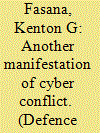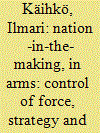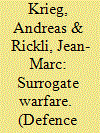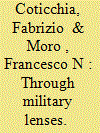|
|
|
Sort Order |
|
|
|
Items / Page
|
|
|
|
|
|
|
| Srl | Item |
| 1 |
ID:
159189


|
|
|
|
|
| Summary/Abstract |
Cyberspace is an avenue of approach through which a military force can attain objectives of value. Through these cyber avenues of approach, military forces can engage, vet, organize, and direct human agents to accomplish specific activities. Although the objectives of these activities could differ from traditional military objectives, they still have military relevance. This particular manifestation of cyber conflict is neither a new domain of war nor something outside of warfare. Rather, it can be viewed as an emerging avenue of approach in the larger context of military operations, auguring benefits in the integration of cyber activities with operations.
|
|
|
|
|
|
|
|
|
|
|
|
|
|
|
|
| 2 |
ID:
159187


|
|
|
|
|
| Summary/Abstract |
Military reading lists, intended to promote professional reading and in turn enhance education and develop critical thinking skills and sound judgement, recommend key texts to military personnel. This is a noble intent but the lists themselves, while generally good, are not flawless. Critiques of military reading lists often focus on what sources they are missing. This article offers its own critique but from a different perspective. It does so by analysing why some sources, which have become outdated, are based on faulty or incomplete research, have been thoroughly disproven, or some combination of the above, nevertheless linger on military reading lists. It then offers a short list of such sources, which it recommends be either removed from existing reading lists or accompanied by other sources that place the original source in appropriate historical context. Where applicable, it also recommends alternative sources that provide insights into the same subject matter. In so doing, this article is intended generate debate and to assist militaries to achieve a better balance between evaluation, induction and retention of valid knowledge on one hand, and rejection of outdated or flawed knowledge on the other.
|
|
|
|
|
|
|
|
|
|
|
|
|
|
|
|
| 3 |
ID:
159188


|
|
|
|
|
| Summary/Abstract |
At the core of waging war and strategy is the creation, control and use of force. This article investigates the volunteer battalions that mobilized in Ukraine during the spring of 2014. It contextualizes the volunteer phenomenon and focuses on the state strategies to establish control over these militias. As ambiguous entities arising from a situation characterized by rapid social change – revolution and war – the volunteer battalions threatened existing hierarchies and questioned state authority. The situation was exacerbated by the war, which deviated from the expectations of Ukrainian combatants and Western military observers alike. The state nevertheless enjoyed a modicum of success in reining in the militias through four strategies of undermining, co-option, incorporation and coercion. While predominantly integrated into a more rigid category of paramilitary forces, the volunteers continue to play a role in both the Ukrainian society and security sector to the unforeseeable future.
|
|
|
|
|
|
|
|
|
|
|
|
|
|
|
|
| 4 |
ID:
159192


|
|
|
|
|
| Summary/Abstract |
According to the NATO’s collective defence strategy and the principle of deterrence, “no one should doubt NATO’s resolve if the security of any of its members were to be threatened”. In this sense, credible deterrence acts as a guarantee for peace and stability in the Euro-Atlantic region. However, recent events in Ukraine and Georgia have revealed the potential weaknesses of the current deterrence models. Without any overt fear of retaliation, we have seen Russia’s aggressive steps towards its neighbours, which were planned and executed with great sophistication, initiative, agility and decisiveness. Although contrary to Ukraine and Georgia which are not the members of the Alliance, Estonia, Latvia and Lithuania are granted security guarantees in the NATO framework, the Baltic countries clearly constitute Russia’s point of contact with NATO and are, therefore, also subject to the interests of Russia to test mutual capabilities and commitment, and to send strategic messages to the Alliance. In this context, the article aims to assess how credible is the deterrence posture provided by NATO in avoiding potential aggression on the part of Russia against the Baltic countries.
|
|
|
|
|
|
|
|
|
|
|
|
|
|
|
|
| 5 |
ID:
159190


|
|
|
|
|
| Summary/Abstract |
The 2015 South African Defence Review set out to reverse the deterioration of South African National Defence Force (SANDF) capabilities. Within the South African Department of Defence (DOD) this deterioration is expressed mainly in terms of a decreasing defence budget, subsequent declining conventional capabilities and obsolete prime mission equipment. Contemporary research and defence expert debates on this theme, point out the disjuncture between policy ends and the available means, with scepticism for an increased defence budget given the DOD’s lack of internal reform and strategy adjustment. One question that remains largely unanswered in the literature regarding the decline of the SANDF, is why both the policy-makers and the SANDF have remained focused on the primary role of the military (defending territorial integrity) accompanied with an unaffordable conventional force design? This question relates to the aim of this paper and is explored by revisiting initial defence policy decisions and compromises that were made in the 1990s. It is argued that the primary role of the SANDF and its conventional force design suited the interests of both the politicians and the military, but that the drawbacks thereof have harshly caught up with the DOD.
|
|
|
|
|
|
|
|
|
|
|
|
|
|
|
|
| 6 |
ID:
159186


|
|
|
|
|
| Summary/Abstract |
Airpower, drones and cyber-weapons are employed by states in conjunction with local armed non-state actors in an effort to coercively intervene in the crises of the twenty-first century. While the externalization of the burden of warfare is a return to pre-modern war, it is the change in the underlying socio-political relations between the state and its military agent that is a novel phenomenon in surrogate warfare. This article demonstrates that in a post-Westphalian era characterized by non-state violence, globalized conflicts, a prioritization of risk management in a mediatized environment, the state has to explore new ways to remain relevant as the primary communal security provider. Thereby, the organization of violence has departed from the employment of the state’s soldier as the primary bearer of the burden of warfare to a mode of war where technological and human surrogates enable the state to manage the risks of post-modern conflict remotely. In this article, we conceptually explore surrogate warfare as a socio-political phenomenon within the context of globalized, privatized, securitized and mediatized war.
|
|
|
|
|
|
|
|
|
|
|
|
|
|
|
|
| 7 |
ID:
159191


|
|
|
|
|
| Summary/Abstract |
The article explores Italian Air Force (ITAF) officers’ perceptions of military transformation and of changes in the global security environment. While several studies have addressed the challenges faced by European armed forces in the last two decades, the methods used have been rather uniform, mostly relying on in-depth case studies through qualitative interviews and analysis of strategic documents and budgets. Using data from an original, and unique, survey conducted among ITAF captains (N = 286), this article focuses on servicemen’s attitudes towards the transformations of the global security environment and the changes occurring (and needed) within the Italian Air Force. After describing the “military view” on these topics, the article provides preliminary statistical evidence on the links between individual experiences, views, and change. The research aims to contribute to the broader debate on military transformation by adding a novel dimension of analysis and providing new insights on the micro-level aspects of learning.
|
|
|
|
|
|
|
|
|
|
|
|
|
|
|
|
|
|
|
|
|